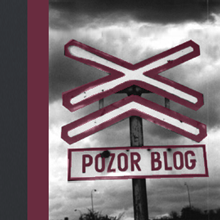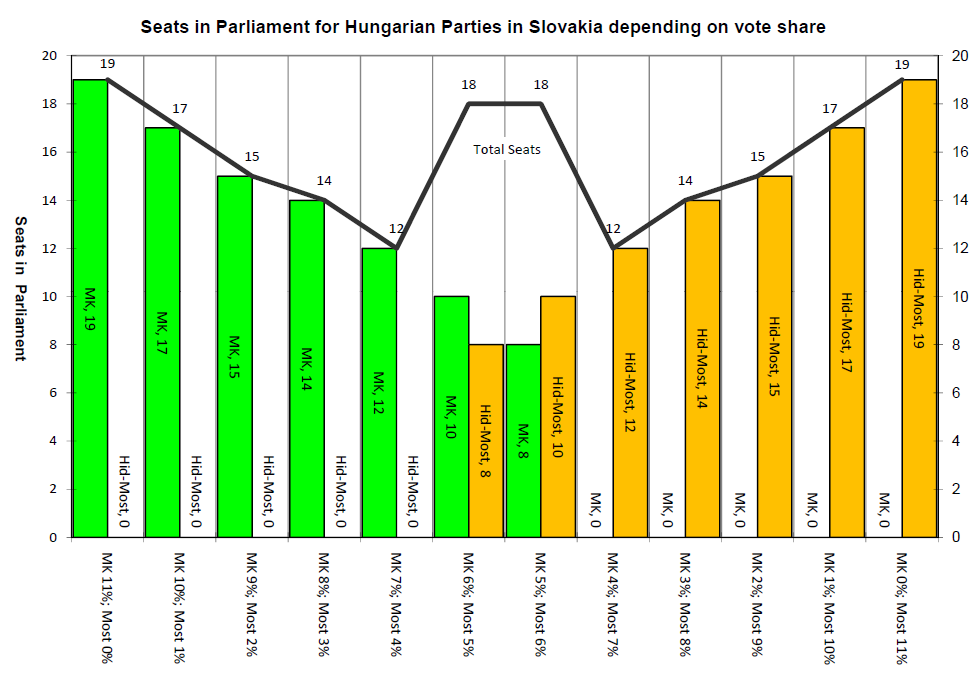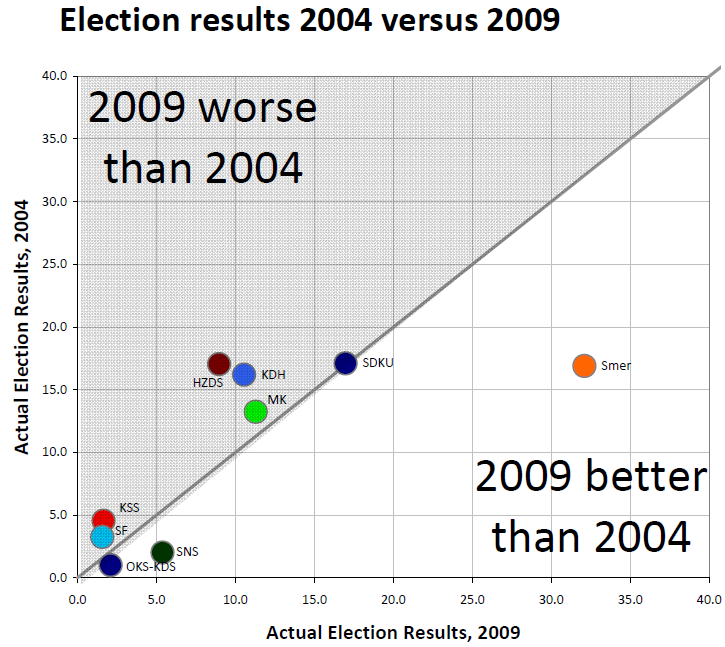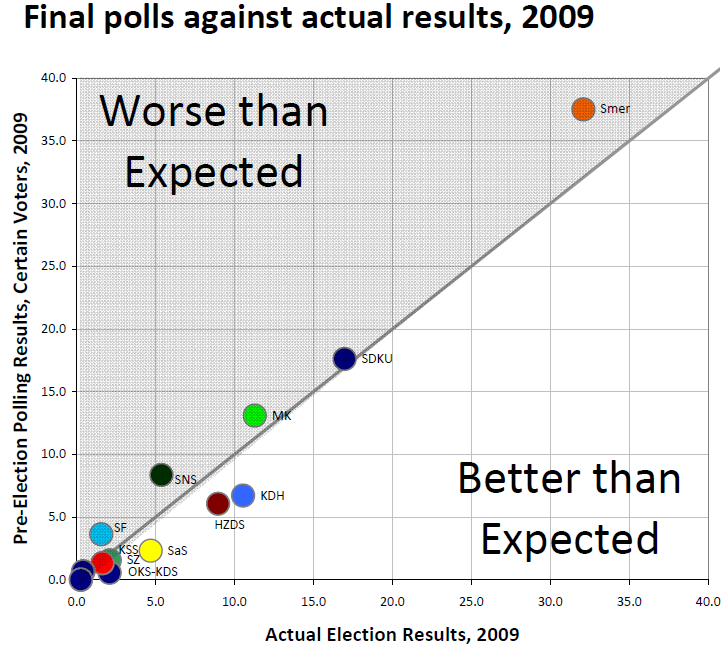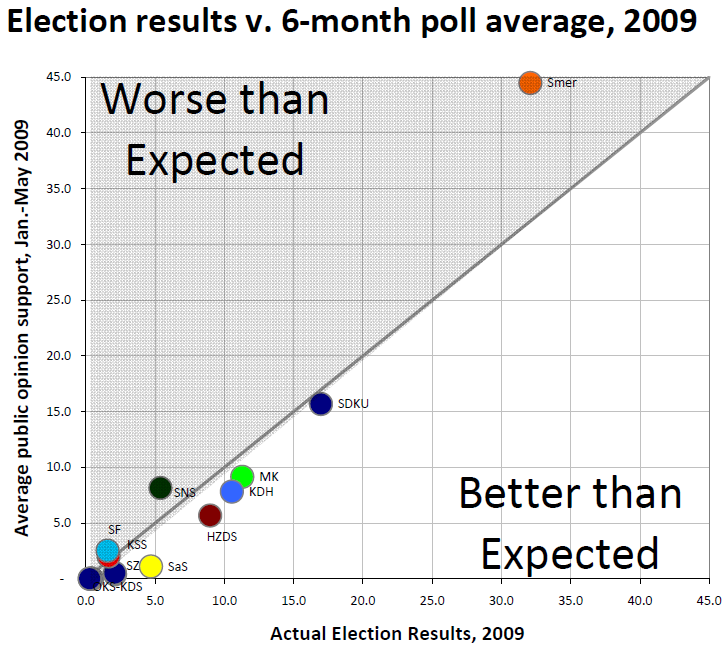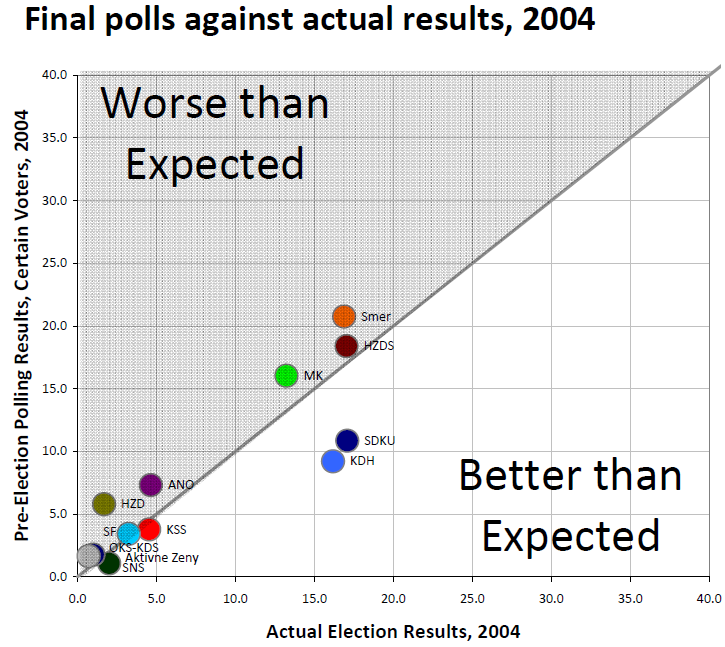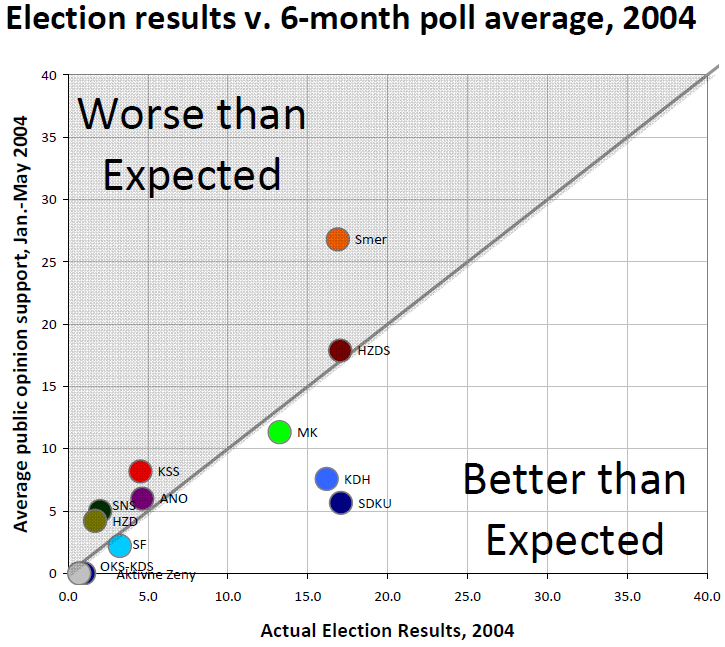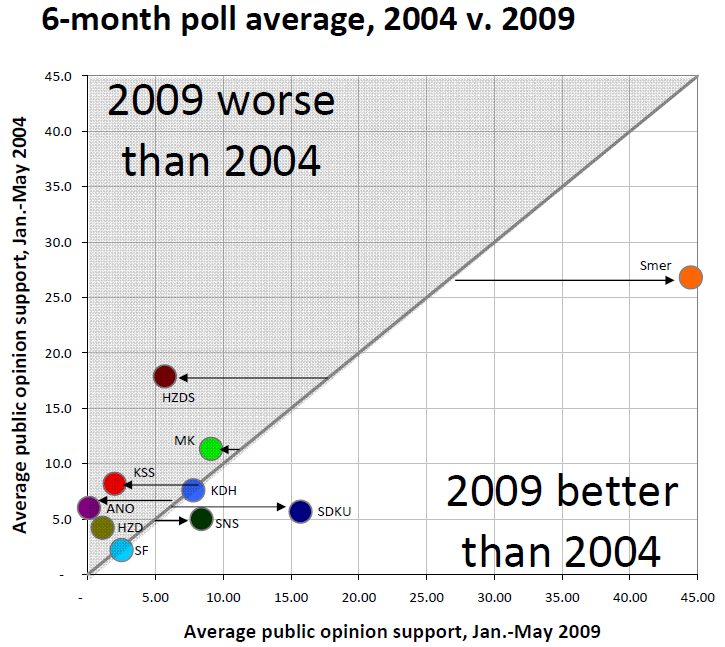 Those of you who are not deeply interested in how Slovaks vote (i.e. nearly everybody) can tune out. Those of you who are interested, I understand your pain, and you can now find all of this blog’s monthly public opinion graphs available in one place by clicking the “Dashboard” link on the top of every page. If it doesn’t work for you, leave a comment that lets me know what browser you are using (I.E. versions seem to have particular problems) and I’ll be glad to send you an updated PDF. I’ll still be inserting graphs in posts, but this is one way to get the data up quickly without spending time on analysis, and maybe that will prevent me from being so late in posting the data.
Those of you who are not deeply interested in how Slovaks vote (i.e. nearly everybody) can tune out. Those of you who are interested, I understand your pain, and you can now find all of this blog’s monthly public opinion graphs available in one place by clicking the “Dashboard” link on the top of every page. If it doesn’t work for you, leave a comment that lets me know what browser you are using (I.E. versions seem to have particular problems) and I’ll be glad to send you an updated PDF. I’ll still be inserting graphs in posts, but this is one way to get the data up quickly without spending time on analysis, and maybe that will prevent me from being so late in posting the data.
Category: public opinion
New publication: How much difference do parties really make?

To watch American television news coverage of political questions (something I can no longer bring myself to do) or even to read American newspapers (only slightly less painful) is to learn that leaders matter. Whether a policy succeeds or fails, whether a candidate wins or loses depends on tactical decisions, on turns of phrase, on the right color tie. To read some America scholarly work on the subject is to learn the opposite: economic conditions, cultural values and demographic trends shape outcomes so strongly that you can set up an accurate electoral model before you even know who the candidates are.
As usually happens (but not always) happens, the answer is usually somewhere in between. But where depends on a whole variety of circumstances. Toward that end I have been working with Zsolt Enyedi to think about how and when agency by parties and candidates can overcome the inertia of structures that include habit, cultural values and group identities. The main outcome of the first stage of our efforts is a still forthcoming issue of West European Politics and a Routledge edited volume on the structure of political competition in Western Europe that includes a long article that Zsolt and I wrote on the topic, but in advance of that volume the European Union Democracy Observatory has been kind enough to print a slightly earlier version as a Working Paper. The paper is available here where it appears alongside work by Marina Popescu and Gabor Toka, Peter Mair and Alexander Trechsel.
Below you can find other particulars. Zsolt and I are moving to the next step in this project and are very much interested in comments, questions, concerns and slashing criticism.
| Title: | Agency and the Structure of Party Competition: Alignment, Stability and the Role of Political Elites |
| Authors: | DEEGAN-KRAUSE, Kevin ENYEDI, Zsolt |
| Keywords: | political parties cleavages structure agency public opinion |
| Issue Date: | 2010 |
| Series/Report no.: | EUI RSCAS 2010/09 EUDO – European Union Democracy Observatory |
| Abstract: | The study of cleavages focuses primarily on constraints imposed by socio-demographic factors. While scholars have not ignored the agency of political elites, such scholarship remains fragmented among sub-fields and lacks a coherent conceptual framework. This article explores both temporal stability and positional alignments linking vote choice with socio-demographic characteristics, values and group identity to distinguish among particular kinds of structural constraints. On the basis of those distinctions, it identifies various methods by which elites reshape structures, and it links those to a broader framework that allows more comprehensive research connecting political agents and structural constraints in the electoral realm. |
| URI: | http://hdl.handle.net/1814/13133 |
| ISSN: | 1028-3625 |
| Appears in Collections: | RSCAS Working Papers |
News and New Resources on Public Opinion in Slovakia
|
Update: Because of formatting problems with certain versions of Internet Explorer , this page is now available as a .pdf file: 2009_12_30 Pozorblog Public Opinion. |
I should begin with apologies for such a long hiatus and also with hearty congratuations to Monika Tódová of SME for writing one of the best articles on the process of public opinion polling in Slovakia: Prieskumy môžu politikov miast. It’s not very long but it finally addresses the problem of dueling headlines–“SaS/Most-Hid poised for success” v. “SaS/Most-Hid has no chance” (often in the same newspaper in the same week) and asks “How is it possible?” The answer lies in the ways that various pollsters survey the public, and it turns out (perhaps I should have known this) that FOCUS and MVK (and previously UVVM) offer a list of parties to choose from whereas Median gives no list. The latter method, of course, will tend to benefit those parties that are best known, while the former can give a boost to parties that are little known (and the process by which firms choose to add parties to their formal lists is fraught with difficulty.
The question now, is whether Todova’s article means a change in approach. Her article is the first instance I can remember outside of election campaigns when an article juxtaposes results from multiple pollsters. I can only hope that this will be the beginning of a trend even if (especially because) it might put this blog out of business. But I’m fairly secure that the time and space constraints of Slovakia’s papers will not let that happen and so there will be room for a blog obsessed with the minutiae of public opinion in Slovakia.
But just so that this blog does not immediately become obsolete, I want to share a new method I’m working on for displaying public opinion results. This is not quite ready for prime time, but using the Timeplot application developed as part of the astounding SIMILE project at MIT, it is possible to create dynamic charts that are fully modifiable and easily updated on the basis of simple text files. Of course that meant that I had to clean up my database, but now that that’s done, I should be able to present updated public opinion results with a minimum of effort (that’s the theory) and can even, theoretically, create a dashboard page on the blog itself for those who want to look at the numbers rather than read my analysis.
Below are examples of what is possible. I’m preparing a year end summary, so you’ll see these graphs again soon with some analysis attached.
September 2009 Poll Results: Whither Smer?
This post comes a bit late because of changes to the pozorblog site but the month’s news is important enough to warrant an interim post.
Things only changed a little this month. But small changes from one month to the next add up. And this month not all the changes are small. A few areas to watch.
Smer
As the image shows Smer remains far above its nearest competitors–still well over double the preferences of SDKU. But the last four months have seen a drop in Smer preferences from the mid-40s to the high-30s. This shift is primarily in FOCUS polls, however, and it is difficult to say whether the result is “real” or some sort of blip. Median, the only monthly alternative, shows no similar drop. I am really missing UVVM this month as it was always helpful to see what a second pollster said before making a judgment, and MVK polls are as unpredictable–in their appearance, not their results–as weather.
 Closer look at Smer polls over time show a gradual increase over the last two years peaking in a cluster in late 2008 and then reverting back to the previous plateau and now, again to a lower level, though whether that lower level is part of a plateau or a slope is something we will have to see about. I suspect next month will show Smer higher in Focus polls but lower than its average level for the last 5 months. I suspect this month’s drop is a bit of an outlier, just as its previous peaks did not always sustain themselves and appear to be noise rather than signal.Smer doesn’t have too much to fear–it’s still hard to calculate a way that it won’t be in the next government, but it wouldn’t surprise me if some mid-level Smer types were starting to work on their political insurance policies.
Closer look at Smer polls over time show a gradual increase over the last two years peaking in a cluster in late 2008 and then reverting back to the previous plateau and now, again to a lower level, though whether that lower level is part of a plateau or a slope is something we will have to see about. I suspect next month will show Smer higher in Focus polls but lower than its average level for the last 5 months. I suspect this month’s drop is a bit of an outlier, just as its previous peaks did not always sustain themselves and appear to be noise rather than signal.Smer doesn’t have too much to fear–it’s still hard to calculate a way that it won’t be in the next government, but it wouldn’t surprise me if some mid-level Smer types were starting to work on their political insurance policies.
SDKU and KDH:
 Take Smer out of the graph and it looks more like a competitive party system. And this fall for the first time in a long time, the two top competitors to Smer are both from the opposition: SDKU and KDH. SDKU dropped slightly this month in FOCUS polls but it’s still near a historic high (in the past it would do this well in elections but not in polls). Some of its slight decline may relate to the rapid resurgence of KDH, a party that has taken a sudden upward jump due, I must think, to the energizing presence of Jan Figel, former European Commissioner. I am interested to see whether Figel’s more proactive approach will keep the party preferences high. In some sense, this does not help the opposition much, since those attracted to Figel are probably those who would otherwise hold their noses and vote for SDKU, but since they might also vote for SaS, it keeps votes among the larger opposition parties. Thumbnails for SDKU and KDH are here:
Take Smer out of the graph and it looks more like a competitive party system. And this fall for the first time in a long time, the two top competitors to Smer are both from the opposition: SDKU and KDH. SDKU dropped slightly this month in FOCUS polls but it’s still near a historic high (in the past it would do this well in elections but not in polls). Some of its slight decline may relate to the rapid resurgence of KDH, a party that has taken a sudden upward jump due, I must think, to the energizing presence of Jan Figel, former European Commissioner. I am interested to see whether Figel’s more proactive approach will keep the party preferences high. In some sense, this does not help the opposition much, since those attracted to Figel are probably those who would otherwise hold their noses and vote for SDKU, but since they might also vote for SaS, it keeps votes among the larger opposition parties. Thumbnails for SDKU and KDH are here:
SDKU——————————————————– KDH
HZDS and SNS:
Slovakia’s two minor governmental parties continue their respective slow slides, partly the result of Smer’s remarkable skill at picking off their voters and partly the result of their own internal struggles and disadvantages. HZDS has stopped falling for the moment but given the party’s steady 10 year slide and absence of anything new that might recommend it, it is hard to imagine anything but continued decline (with the key question: 5% or not 5% next June). SNS’s decline has been disquised at times by the party’s erratic support shifts but it is notable that all of the trendlines (24-month, 12-month, 6-month and 3-month point down at almost the exact same angle). The party has more leeway for falling than HZDS but it is not immune, and at some point SNS mid-level leaders are going to need to decide what to do if they feel that Jan Slota is pulling them down. The party’s structures are so focused around the party chair that the only way to force change will be to leave, but the last time they did that the parties split the electorate 50/50 and neither got into parliament.
SNS——————————————————– HZDS
SMK and Most-Hid
Not much to say here, yet. For two polls in a row both parties are poised to make it into parliament. If this can continue then Bela Bugar has done a big favor to the Hungarian electorate, bringing back those disenfranchised from SMK. If both don’t stay above 5 and neither drops to near-zero, then the Hungarians will see their poorest electoral showing since the early days of Slovakia’s democracy. I’d be keen to hear any thoughts from Magyarophones about what to expect here as this is a subset of the population from which I hear little direct news.
SMK (regular graphs for Most-Hid coming soon)
Smaller Parties:
Not much news here this month. SaS shows staying power at around 3%, and KSS recovered this month to its traditional 3% levels as well (though it has not been there for awhile). Below, around 2% stands SF (recovering slightly from a major drop the previous month) and at at the flatline level are OKS, KDS, ANO and Liga (which didn’t get a single person to mention it’s name this month even though it’s on the list). Between them are two more: HZD (slightly higher than expected–it’s been flatlining) and the Greens (somewhat lower than expected–last month it even beat KSS).
What it all means? The Coalition Partner Game
It’s still Smer’s ballgame, but coalition politics could become extremely interesting if Smer does end up at around 35% and HZDS or SNS fall below 5%. It is dangerous to trust what parties say about potential coalition partners, but as of now, SDKU and KDH appear to have ruled out coalition with Smer (Dzurinda is right, I think, to note that such a coalition would severely hurt his party, and he doesn’t have the organization or track record to ride it out the way ODS and CSSD did with their opposition agreement in the Czech Republic). But if this option truly is gone, then there are few other combinations that can make 50%. If the existing coalition can’t muster 50% because one party drops off, then Fico would need to find alternatives, but (even though I generally do not rule things out) there will be no coalition containing both SNS and either SMK or Most-Hid, and SaS, the only other party that looks now to have a chance, has promised up one side and down the other that it will not join forces with Smer. So Smer’s only real chance is probably SNS+HZDS or so many votes for parties that fall below the threshold that it can with SNS or HZDS form a bare majority government.
At the same time, there’s not much hope for a government of the current opposition parties. Even with SDKU and KDH and SMK and Most-Hid and SaS, there’s nothing like a majority. It might be possible to create one by adding HZDS to this but even that’s unlikely and HZDS is the party in greatest danger of falling short. In 10 short years, HZDS has gone from a huge and polarizing force in Slovakia’s politics to a tiny but necessary coalition partners. The more things stay the same, the more they change.
Wanted: Effective journalism in Slovakia
 I know Slovakia’s journalists are overtaxed with all that is required of them, but there are things they could do to make things better without too much extra work. Case in point: today all major Slovak news sources today report, almost word for word, a press release from the firm Median reporting poll results from July:
I know Slovakia’s journalists are overtaxed with all that is required of them, but there are things they could do to make things better without too much extra work. Case in point: today all major Slovak news sources today report, almost word for word, a press release from the firm Median reporting poll results from July:
- TA3: http://www.ta3.com/sk/reportaze/129612_prieskum-volby-by-vyhral-smer-sd
- SME: http://www.sme.sk/c/4984048/smer-zostava-napriek-poklesu-najsilnejsou-politickou-stranou.html
- Pravda: http://spravy.pravda.sk/v-prieskumoch-nic-nove-smer-valcuje-d6s-/sk_domace.asp?c=A090821_105906_sk_domace_p12
- HN: http://hnonline.sk/slovensko/c1-38118610-fico-aj-slota-padaju-kauzy-im-skodia
The reports differ a bit, of course: SME and TA3 have a graph, Pravda has a table with past results from Median, HN relates the results (with no actual evidence) to the effect of recent scandals.
What none of them does is to answer the important question about Most-Hid. Median, for reasons that are not clear, does not report on parties that do not cross the 5% threshold, and all the papers report that fact. What they do not do is to say just how well Most-Hid actually did. Here’s where journalism comes into play. If the role of journalist goes beyond simply typing (or in this case probably pasting what others send to you) then it may be to try to find answers to important questions.
So here’s my suggestion: call Median and ask them
If Median won’t answer, ask them why. Focus reports its polling results with an extremely detailed and effective one-page report. UVVM used to do the same. There is no reason the papers should print Median’s results unless they are willing to rise to the same (bare minimum) standards. If Median won’t play that way, write a story about the fact that Median won’t provide necessary information):
If Median won’t answer and you still want to figure out something about Most-Hid’s initial support (a quite important detail), here’s my second suggestion: do some math.
If you add up the total support for the parties listed by Median in past polls, you get a consistent result of about 97% for May and June. That means other parties are getting about 3% (specifically 3.1% in May and 3.3% in June). If you add up the total support for July you get 92.3%. That means other parties got 7.7%. Of course this doesn’t tell you how well particular parties did, but it’s worth reporting that the “Other” number rose by 4.4% and citing the FOCUS numbers which show that support for below-threshold parties actually did not change systematically during the same period (9.0% in May, 12.5% in June, 10.2% in August), meaning that a large share, of not all of the 4.4% probably went to Most-Hid.
Total cost of these important details: one phone call and/or 2 minute 3o seconds of addition and subtraction.
If this lack of effort applies in this specific area, it’s probably also true in areas where I do not read. It’s time for Slovaks to demand better journalism.
Less than perfect public opinion coverage in Slovakia
[Citajte post aj po slovensky]

![]() “Less than perfect” could be the title of nearly post on polling coverage in Slovakia (hence, in many ways, this blog), and I shouldn’t be too critical but today both major papers went out of their way to mangle polling data.
“Less than perfect” could be the title of nearly post on polling coverage in Slovakia (hence, in many ways, this blog), and I shouldn’t be too critical but today both major papers went out of their way to mangle polling data.
In SME: “New party Most already clearly drawing Csaky voters” cites a Polis poll showing SMK at 5.7%. Not only does the paper fail to assess whether Polis does good polls (they use telephone surveys which are problematic and they haven’t released a party poll for a long time so we just don’t know for sure–but more on that in a later post) but it suggests a trend–and a causal relationship even–on the basis of one data point. We simply don’t know how SMK polled in previous Polis polls this year because there haven’t been any (at least I haven’t seen any and the paper certainly doesn’t provide them, using the 2006 elections as a frame of reference, as if that told us about polling trends). Other polls did show SMK higher in previous months, but all polls do not sample populations the same way, and even UVVM had trouble with even samples of the Hungarian population (http://www.pozorblog.com/?p=110), and showed a result for SMK as low as 6.7% in September of 2008. I’m not saying that Most-Hid is not pulling away SMK voters–in fact I suspect it is–but there’s no way of knowing it from the information we’ve got here.
In some ways worse, both SME and Pravda use the same data set to talk about the woes of HZDS. SME simply makes the same mistake as above, suggesting that “HZDS continues to decline” on the basis of only the one Polis poll, without attending to the fact that different polls show different levels for parties and ignoring the fact that this month’s FOCUS poll show’s HZDS rising by more than a point, from 4.2 to 5.3. Pravda’s story, “Meciar not bothered by polls“ does something rather worse, citing not only the Polis poll but also the numbers from FOCUS for April (4.8) and May (4.2) without feeling obliged to report the big increase reported in June. It is clear to me that HZDS is in trouble, (and these microtrends usually don’t add up to anything, so I wouldn’t argue that HZDS support is actually increasing), but citing the first two numbers of a sequence of three seems a bit beyond the pale when the third number tells the opposite story.
New Parties: SaS does the electoral math
 Interesting post today from Richard Sulik, founder of Sloboda a Solidarita (trendily-colored logo is at left, found not on a party website but on a Facebook page), who responds to the charge from SDKU that SaS hurt the right by causing voters to “waste” votes on a party that did not make it over the threshold (http://richardsulik.blog.sme.sk/c/196401/SaS-oslabila-pravicu.html).
Interesting post today from Richard Sulik, founder of Sloboda a Solidarita (trendily-colored logo is at left, found not on a party website but on a Facebook page), who responds to the charge from SDKU that SaS hurt the right by causing voters to “waste” votes on a party that did not make it over the threshold (http://richardsulik.blog.sme.sk/c/196401/SaS-oslabila-pravicu.html).
Sulik makes interesting arguments to suggest that SaS voters had good reason to vote in other ways and that they might not have voted at all, but he also makes good use of electoral math to make his point: he uses the electoral formula to show that reallocation of all SaS to SDKU would only have reallocated the number of seats that went to the right (SDKU would have gained one but KDH would have lost one) and thus that SaS did not impact the final result. The math looks solid to me and it is nice to see someone respond to arguments by looking at actual numbers and rules.
Nevertheless, it is not as easy to dismiss the SDKU arguments if they are seen as a warning about future elections. SaS did not have much impact in the European Parliament elections because there were so few seats at stake (13 [Correction, thanks reader “Richard”). Had it been a parliamentary election (and yes, many other things would have been different as well), Sulik’s argument is not quite as strong. I’ve reworked his numbers assuming the 150 seats of Slovakia’s parliament at stake. According to this, calcuation, SaS would have had a significant impact on SDKU votes (which would have gained 6 seats had it received all of the SaS votes) which is partially but not completely ameliorated by its impact on KDH and SMK (each of which would have lost a seat). In terms of coalition and opposition, this is almost a crucial difference: from clear parliamentary majority for Smer-SNS-HZDS to a bare majority that would hinge on the decision of only two deputies.
European Parliament Election Results if 150 seats (the Slovak Parliament) were available for election, according to two hypotheses:
| Party | SaS supporters vote for SaS | SaS supporters vote for SDKU |
| Smer | 56 | 53 |
| SDKU | 30 | 36 |
| SMK | 20 | 19 |
| KDH | 19 | 18 |
| HZDS | 16 | 15 |
| SNS | 9 | 9 |
| Smer+HZDS+SNS | 81 | 77 |
| SDKU+SMK+KDH | 69 | 73 |
Of course this is all theory, but the underlying debate is deeply relevant. The more the fragmentation on the right, the worse it is likely to do (as the left and the Slovak nationals demonstrated in 2002), but it is not a zero-sum game and it may be true that Sulik’s party brings out new voters. His ability to mobilize certainly is apparent in this election. The question for me is whether the best use of Facebook/youtube/social networks is enough to attract the 115,000 voters who will likely be necessary to get a party over the 5% threshold in 2010? The effort is certainly worth watching.
New Parties: Most-Hid now on display
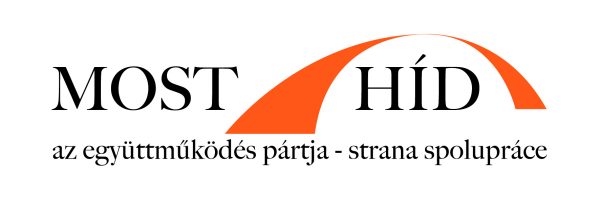 For a party whose name looks in English to mean “least visible” this party will be getting a lot of attention over the coming year. Founded by Bela Bugar, former head of the Party of the Hungarian Coalition (SMK), it may change Slovakia’s political landscape. Or maybe not.
For a party whose name looks in English to mean “least visible” this party will be getting a lot of attention over the coming year. Founded by Bela Bugar, former head of the Party of the Hungarian Coalition (SMK), it may change Slovakia’s political landscape. Or maybe not.
The party’s name actually means “Bridge” in both Slovak and Hungarian. This allows a nice pun by SME–“Bugar’s people divide Hungarians with a bridge (http://www.sme.sk/c/4881801/bugarovci-rozdelili-madarov-mostom.html)–and prompts a lot of speculation by a lot of people about the nature of the new party. In fact, I suspect that it would be difficult for any predominantly Hungarian party to attract more than 1 or 2% of the Slovak electorate, though European election results from this weekend suggest that minority-focused parties can attract more than their ethnic share if the other parties are in bad enough odor. Nor do I think that the new party, despite its name, necessarily expects to gain a large number of Slovak voters. The debate here is primarily about what happens within the Hungarian community.
At first glance, creation of a second major party to represent Slovakia’s Hungarian minority seems extremely dangerous in a country where the electoral threshold is 5% and the Hungarian population hovers around 11%. The Slovak National Party (SNS) here represents the worst case scenario: in 2000 it split its 8% electorate almost exactly down the middle (disillusioning a few of its supporters in the process) between SNS and the “Real” SNS (PSNS) in such a way that each half got 3.5% and neither made it over the threshold. With this example in mind, the establishment of Most-Hid looks like a gamble, especially since, the split follows the SNS-PSNS in another key way: one party gets the more popular leader but little organization, while the other gets the organizational continuity and the uncharismatic new leader who threw out the other one. The difference, however, is significant as well: unlike SNS voters (who could always turn to HZDS) Hungarian voters do not have anywhere else to go, and given the minority status of Hungarians in Slovakia they are relatively well-habituated to turning out rather than staying home.
Given these conditions, what is the likely effect of Most-Hid on overall election results. Well in the first place, Bugar has been careful not to exclude the possibility of an electoral coalition with the party he just left, which would more or less return the situation to the pre-1998 situation in which two Hungarian parties competed for share of vote but approached elections in coalition. Even if the parties do go into the election separately, the results may actually not be catastrophic for the Hungarian population. The graph below starts with today’s electoral environment and makes the assumption that a combination of two Hungarian parties will receive 11%. (This is a conservative estimate, slightly below the party’s recent totals in the mid-11% range. Of course it is possible that bitter competition between two Hungarian parties could turn voters off, but it is just as possible that having more defined choices might bring some Hungarians back to the voting booth and, just maybe, that Bugar could attract a few Slovaks, so 11% is probably a bit low.) Under current conditions, a party with 11% would gain 19 seats, one short of SMK’s take in 2006. For the sake of argument I assume that each point gained by Most-Hid reduces the support for SMK by the same amount and then calculate the number of seats according to the current Slovak method for alloting parliamentary seats:
First, and obvious but it should be said, unless the Hungarian party electorate falls below 10%, the emergence of Most-Hid won’t replicate the SNS-PSNS mutual destruction. One of the two parties will gain representation. The next-worst-case scenario not impossible but it is also not as grim as it might seem because of the workings of the electoral system. If Most-Hid (or SMK) were to get 4.99% and the other party 6.01%, the total share of parties would certainly fall short of the possible score, but not by as much as one might suppose since, with fewer parties above the threshold, parties get more seats per vote. As a result, the likey minimum score for total Hungarian representation is 12 seats. Furthermore in half of the scenarios above (I cannot say which is most likely), Hungarian representation does not drop by more than two.
The fact that the creation of Most-Hid threatens a drop but not an elimination of Hungarians in parliament may help to explain Bugar’s calcuations. The step won’t ruin his reputation and increases his options. It is not impossible that Most might be able to attract a significant share of SMK support and become the dominant of the two partners, allowing Bugar to dictate terms, allowing the possibility of an electoral coalition with SMK, even leading to the ouster of Csaky from SMK and a re-unification under Bugar.
Add to this the probability (diminished slightly but still extremely high) that Smer will form the next government and the fact that some within Smer have already responded positively to Most-Hid’s creation (http://spravy.pravda.sk/smer-chvali-bugara-sdku-stoji-za-csakym-d94-/sk_domace.asp?c=A090610_085204_sk_domace_p23) and the creation of the party actually looks like a well-calculated risk. Even the timing is relatively good: a year ahead of elections is enough for the party to build an organization but not too long for the party to languish in opposition obscurity.
Smer may be the real winner in all this: if Most makes it over the threshold, the number of possible coalition partners increases and therefore so does Smer’s bargaining power. If Most does not make it over the threshold but draws away a significant number of voters from SMK, then the seats SMK might have won are redistributed upward and some of them will go to Smer.
The real loser in this are those political scientists (by which I mean myself) who argued that SMK’s strong internal organization and decision-making mechanisms made it more stable and less likely to fragment. But perhaps those same researchers can recover by shifting their focus to study new parties.
—–
One interesting side note: at the time of with the rather poorly-planned announcement of Palko’s KDS, which at the time had neither a website, logo or even name, I have been conscious of how politicians in Slovakia miss chances for using early publicity to establish a brand that no private firm would ever miss. So on the day the rumors about Most-Hid finally reached the daily press I checked to see if anybody had established a Most-Hid website. No, but they did do so by the following day, though the website is empty except for the logo.
Interestingly if I read Whois.com right, the party had already claimed the domain name about 3 weeks ago, at a time when discussions between Bugar and Csaky were still going on! Plus two points for prior planning. Minus one point for good faith bargaining.
Domain-name hid-most.sk [and most-hid.sk] Admin-name Websupport, s.r.o. Admin-address c.d.457, Kysucky Lieskovec 02334 Admin-telephone 0904/306 081, 0904/306 081, 0904/306 081 Last-update 2009-05-16 Valid-date 2010-05-12 Domain-status DOM_OK
European Parliament Elections, Slovakia 2009
A few initial thoughts (perhaps my only thoughts) on Slovakia’s Europarliament Elections.
In general there are few surprises here: Smer wins, SDKU follows at at a great distance, along with SMK and KDH. Perhaps the only superficial surprise is the apparent reversal of numbers for SNS and HZDS, but even this is not particularly surprising in light of other characteristics of these parties. As usual, it helps to look at the results against the background of polls and the previous Euroelection. Full election results with comparisons to 2004 and to various polls are here and in a table at the end.
First, how does this look in comparison to the last (i.e. first) Euroelections in Slovakia, held in 2004. Turnout appears to be slightly up, but slightly up from the lowest in Europe is still just the lowest in Europe. In terms of party results, I’ve created a series of charts that array the parties on the Y (vertical) axis in terms of past performance, according to a variety of markers and the X (horizontal) axis in terms of present performance in elections. Do that for the 2004 and 2009 results and here’s what you get:
As is obvious, Smer does far better than before (over 30% compared with its disappointing under 20% in 2004), picking up 5 seats instead of its previous 3 and far outpacing the rest. SDKU is next with results almost identical to those of 2004. Following a bit behind in a tight cluster are MK, KDH and HZDS, all performing worse than in 2004, by various margins and for various reasons (but more on that later) and then just above the 5% threshold, SNS. All parties currently with seats in Slovakia’s parliament get Europarliament seats and no non-parliamentary parties make it across the threshold).
Clearly, by this standard 0f 2004 we have a major victory for Smer. But there are other metrics. A second way to look at this is to compare it to the most recent poll, does it beat expectations? By that standard, this is what we get:
Smer and SNS do worse than expected, SNS by a slightly smaller raw percentage but a much higher relative share. SMK does slightly worse than expected while KDH, HZDS and SAS do better. What explains these differences? Two of the three parties that did worse than expected also have the reputation (backed up by some research I’ve done) for weaker than average organizations. In a low turnout election, organization makes a difference. KDH and HZDS both have better than average organizations and and relatively stable, older than average electorates who dutifully turn out to vote. SMK is also fairly well organized, but the party is currently in the midst of major turmoil (more here and more from me later). The interesting addition to this list is SaS–Sulik’s Freedom and Solidarity. New parties in Slovakia have rarely developed organizations that could push turnout in this kind of election, but Sulik appears to have made effective use of online social networks and other similar structures to mobilize young, educated voters who might otherwise stay home. The bad news for SaS is that they just barely missed the chance to shake things up by getting a seat that would gain them some visibility and the same techniques will not have the same impact in higher turnout parliamentary elections in 2010. Still, SaS will comes out of this strengthened vis-a-vis other small social-liberal parties (SF and Liga with quite bad performances, and the Greens not moving beyond their very small base) and has an opportunity to pick up the “disaffected SDKU” vote. OKS-KDS did better than the previous year: Palko’s presence helped, no doubt, as the only party leader on the ballot of any party, but the party’s inability to push much beyond 2% in this election does not bode well for 2010. KSS continues to hover around 1.5%, as it does in the polls, without much immediate hope of revival.
Finally, we can look at these results against the general recent performance of parties at the national level, averaging scores from FOCUS polls (now the only major one left that reports results fully and regularly) since the beginning of the year:
The results here are not wildly different from the previous graph, but it does suggest some cause for concern by Smer. A 32% result in the Euroelections is great if it is double that of your next largest competitor, but slightly worrisome if it is 14% lower than the party’s average for the year to date. Of course this is a low turnout election (this happened to Smer before in 2004, and even worse) but 2010 may not be particularly high either. As with the presidential election, the results suggest that even with rather poor political play, the right wing manages to do better in elections than in the opinion polls (which show SDKU, SMK and KDH hovering around 30%-35%. For now Smer is so far ahead that this makes little difference, but the party cannot afford to be complacent, especially, unlike its predecessor HZDS which once found itself in a similar position, Smer does not have such a strong organizational base to fall back upon.
The actual numbers are available online at Google Docs:
http://http://spreadsheets.google.com/pub?key=pdhlCClsiyAMi39bLFpY_Zg&single=true&gid=3&output=html
And the most recent three months are below in tabular format (using “iframe” which may not work on all browsers).
<br />
——–
The main points are above, but in the process of making them, I made a few others that I don’t want to waste. First, the polls v. results that parallels the one above.
Here we see Smer’s slightly worse-than-expected performance and the dramatically better-than-expected performance of SDKU and KDH in 2004. This is even more apparent in the poll average graph:
By this standard, 2004 really was a negative shock for Smer and a hugely unexpected bonus for KDH and SDKU and even to some extent for MK. Here we see the “party organization” factor in full effect.
Finally, a graph that has nothing to do with the Euroelections but was calculated incidentally. Still, it’s striking in what it shows:
This blog has been talking about shifts in public opinion for some time, but this provides a great time-lapse image. Smer is way up. SDKU is up (though up over its polling numbers while in government rather than its actual election figures) as is SNS (though in 2004 it was coming off a disastrous couple of years after the PSNS split. Its historical figures are actually around this level). KDH is remarkably stable over time and has been since the mid-1990’s. The losers are the small parties: KSS and ANO falling from electoral viability to near-death and HZDS falling from near-front runner to barely viable. Amid all of this perhaps the most striking thing to me is the negative movement of MK. This is a party which, except for actuarial reasons, should not move at all and yet it has fallen by several points. Some of this may be the loss of a few Slovak voters who in 2004 still saw it as a clean alternative to the other members of Dzurinda’s then-coalition, but the party’s drop over the last 2 years suggests that it is due to poor politics. Now we shall see what happens when there is an alternative party, but that is a topic for the next post.
April 2009 Final Poll Comparisons
There is an old Communist-era joke in which one character asks the other, “Why weren’t you at the last party meeting?” and the other responds “If I had known it was the last party meeting, not only would I have shown up but I would have brought a bottle of champagne.” In a similar–if more unfortunate vein–when I talk about the last UVVM survey of public opinion in Slovakia, I mean the last one. The Statistical Office of the Slovak Republic has stopped the monthly public opinion polling on parties that gave Slovakia one of the most robust public-opinion tracking data of any country in postcommunist Europe. The office has been discussing this for over a year (the director of the office, Ludmilla Benkovicova, discussed this with me in an interview in June 2008 and it was in the air well before then) but it is awkward for all concerned that the polling ceased precisely at a point when, according to a report by Pravda (http://spravy.pravda.sk/hzds-a-sns-nepadli-popularitu-straca-len-smer-faz-/sk_domace.asp?c=A090425_120119_sk_domace_p23) the ruling party, Smer, allegedly received its lowest support in over a year-and-a-half, and the ruling coalition allegedly received its lowest support since the June 2006 election. I write “allegedly” because in addition to ending the party preference polls, the Statistical Office also embargoed the results of April poll that included those numbers and we have them in the public realm only because Pravda claims to have obtained a copy (which it also claims that Benkovicova did not deny).
It is hard to know what to make of Benkovicova’s decision since she cites an EU directive with which I am not familiar and since it is possible to make a good argument against government sponsored polls as the centerpiece of a country’s polling infrastructure. At the same time, UVVM has done excellent work and has seemingly remained immune from political pressure. Furthermore, while the circumstances and motives of the current decision might be entirely different, it is also worth noting that the last time UVVM stopped public release of polling information on political parties, it was during the government of Vladimir Meciar. The polls came back after Meciar left. We shall see if they do so again after Fico’s departure.
Because of the informal nature of the release of the UVVM April data, we only have a partial range of figures (none of the smaller parties or the share of non-voters) but fortunately we also have numbers from FOCUS for the most recent three months. There are also numbers from the firm Median but I am hesitant to put these into the broader model as they lack the track record of the others. I will try to do some more analysis of Median numbers and see over the next few month whether these are worthy of inclusion.
So what do we find. The graph averaging the last 24 months of polling results from multiple sources shows a drop for Smer back to the plateau it reached during the final months of 2008, the first time since the 2006 election that Smer has seen three consecutive months of drop.
The drop comes off a record high, however, and so the news is not terrible, especially since while UVVM numbers showed a big drop (to 40%), FOCUS numbers showed the party increasing slightly.
This graph averaging the last 4 months of polling results from multiple sources shows this in more detail and suggests a minor shift in the overall dynamics of party competition. Whereas originally there had been 4 groups of parties (Smer on its own above 40, SDKU and SNS between 10 and 15, HZDS, KDH and SMK between 5 and 10 and then a group of parties under 3, there are now 4 different groups (Smer alone, still above 40, SDKU in clear second above 15, SNS, KDH and SMK between 5 and 10 and parties under 3.
This graph of recent polling results for SDKU shows a strong recovery–some of the highest poll numbers SDKU has ever had–perhaps because of the relatively strong performance by its presidential candidate, Iveta Radicova–but this bump may not long survive Radicova’s return to relative obscurity.
This graph of recent results for SNS shows a consistent, slow drop even before the most recent ministerial scandals. I am curious whether the apparently high levels of clientelism within the party can dislodge even its most passionately anti-Hungarian voters.
The wildcard here is HZDS. In a February blog entry, I wrote that
“there is a strong chance that the party will post at least one or two results below the 5% threshold in the months just before elections, a symbolic result that could further hurt the party’s chances.”
That moment came sooner than I expected, at least in FOCUS surveys and so significant was the drop that I had to change the scale of the HZDS graph.
HZDS has a strong cadre of loyal voters–stronger than most other parties of similar or even larger size, but at present the party’s slide is accelerating rather than slowing. The current numbers put HZDS soon in the under 3% group. The best case scenario for the party is somehow to hang on near the bottom of the 5%-10% group.
In broader terms these changes suggest a small closure of the gap between opposition and coalition parties, but the gap is still almost as large as the percentage of the opposition parties themselves. It would take a lot to close the gap completely though of course “a lot” is what the current world economic crisis threatens to deliver.
The long-term graph of poll results for (loosely defined) party “blocs” parties shows parallel declines in the “left” and “Slovak national” blocs of parties and some aims for the opposition “right” bloc, but this again is not nearly enough for a change of government.
This month’s distribution of parliamentary seats shows Smer still in a position to form a one-party government with any partner, though its most likely partner, the Slovak National Party, is the one which has seen the dismissal of two ministers and a variety of other criticisms in a short period (though a variety of Slovak analysists suggest that the party needs its government posts (and the wealth to which they give access) too much to complain (http://spravy.pravda.sk/koalicia-vydrzi-sns-potrebuje-zostat-vo-vlade-zhoduju-sa-analytici-1pv-/sk_domace.asp?c=A090505_170429_sk_domace_p23)
And finally, because they did not fit into the narrative above (if such a disjointed string can be described as a narrative), a few other specific poll numbers.
The graph of recent results for MK shows stability and a degree of convergence among polls at around 8.5%. The surveys were taken before Bela Bugar left the party’s parliamentary delegation, however, so we shall see over the next two months whether that has any effect. We shall see over the next year whether we have a full split on our hands here. If so, the normally solid representation of Hungarian parties in parliament may come under threat.
This graph of recent results for KDH shows convergence as well with little change in average over time. This is the one party to which nothing has happened over the last several months so the stasis is not unexpected.
The graph of recent results for KSS shows a drop, particularly noteworthy since FOCUS numbers which usually put the party around 2% put it here under 1% for the first time in about a year.
Finally the graph of recent results for SF shows a steady rise. Whether this party is a contender for 2010 (I predict that some pro-market social liberal rival to SDKU will flirt with the threshold in the months before the next parliamentary election but I don’t know that it will be SF, though that party has a better chance than some. It has something of an organization and some name recognition, while neither Liga nor SaS appears to have yet found legs, but there may be another contender out there somewhere as well.
FOCUS numbers show a stable 1.1% or so for the Green party (ZS) in the last two month, and really low numbers (between 0.1% and 0.5% for Liga and KDS. OKS actually appeared above 0.0% for the first time in years (perhaps because FOCUS is asking about it now), and its emergence significantly undercut KDS (if anything can be called significant under 1% or understood as anything other than random noise.)
As always, the actual polling numbers are available online at Google Docs:
http://spreadsheets.google.com/pub?key=pdhlCClsiyAMi39bLFpY_Zg
And the most recent three months are below in tabular format (using “iframe” which may not work on all browsers).
&amp;amp;amp;amp;amp;amp;amp;amp;lt;br /&amp;amp;amp;amp;amp;amp;amp;amp;gt;
